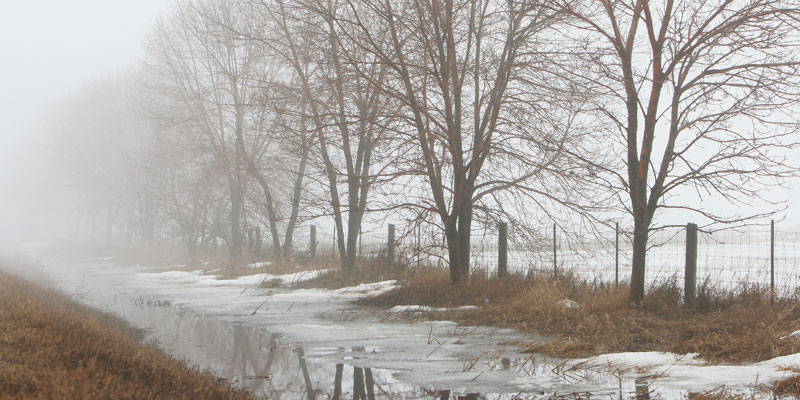Degradation of Emerging Pollutants by TiO2 Nanowire Membranes during Water Treatment
Principal Investigator - Y. Norman Zhou, Professor, University of Waterloo, -

Challenge
With a rapidly growing urban population, there has been a subsequent rise in municipal wastewater effluent discharge, resulting in multiple challenges for urban waterways, particularly when it comes to pharmaceuticals and personal care products (PPCPs). Wastewater treatment plants were not designed to remove PPCPs from their effluents. Thus, many residues of these compounds have been detected in wastewater effluent, ultimately ending up in surface water bodies that serve as raw drinking water sources. Despite being present in very small concentrations, public mistrust of drinking water from municipal sources post-Walkerton has municipal water managers concerned over the widespread detection of PPCP residues. Traditional techniques used to disinfect raw drinking water, such as chlorination, are largely ineffective at removing many PPCPs, while advanced methods, such as reverse osmosis, are very effective, but costly.
Recent technology advances are generating new materials with unique surface-active properties, which may help to remove PPCPs from raw water sources. This research proposal aims to address whether titanium dioxide (TiO2) nanowires, structured as membranes, can mechanically filter, adsorb, and degrade a range of PPCPs.
Project
The overall goal of the project was to develop TiO2 nanowire membranes as an innovative water treatment technology, particularly for the removal of emerging contaminants like PPCPs.
In order to develop this technology, researchers sought to describe mechanical filtration cut-offs, evaluate TiO2’s ability to alter chemical reactions using ultraviolet (UV) light, and evaluate how efficiently TiO2 removed a sub-set of PPCPs. A series of experiments were conducted to evaluate the nanowire membranes’ structural growth, which involved characterizing porosity. PPCP removal rates via TiO2 nanowire membranes were tested with and without UV light, and contrasted against current commercial practices. The results demonstrate that UV-induced TiO2 degradation is a viable mechanism for PPCP removal.
Ongoing research is occurring for a broader suite of PPCPs, with a variety of physical and chemical properties, which will give insight into degradation mechanisms. This in turn will help determine whether PPCPs are being completely mineralized, or are merely degrading into smaller compounds, which may retain some of the original biological properties.
The project has also had considerable success with studies investigating how PPCPs adsorbed in the presence of the nanowire membranes. Experimental evidence suggests that adsorption would reach equilibrium after 20 to 30 min. More recently, attention has focused on the ultra-filtration properties of the TiO2 nanowire membranes, specifically investigating how the mechanical properties can be dramatically improved by bringing silver into the mix.
Finally, the researchers have made progress on designing a prototype closed-cycle filtration system using UV light.
Outputs
- In 2013, a three-year NSERC Strategic Project Grant proposal entitled “Removal of drinking water contaminants with innovative TiO2 nanowire membranes” was successfully funded.
- In February 2012, the research team chaired the section on “Nanotechnology in Water Treatment and Sampling Applications” in the 47th Central Canadian Symposium for Water Quality in Burlington. An estimated 30 researchers attended the section.
- In April 2012, a technical presentation titled “Nanotechnology for innovative water treatment” was given to Conestoga Rovers & Associates.
- Research progress was reported by Water Canada in a piece entitled “A Bitter Pill” in January 2012.
- In February 2011, the research team chaired the section on “Nanotechnology for Water Treatment” in the 46th Central Canadian Symposium for Water Quality in Burlington. An estimated 30 researchers attended the section.
- A presentation was made to the symposium “Nanotechnology for Energy and Environment” at Material Science & Technologies 2011 in Columbus, Ohio, USA, at which, more than 50 researchers and industrial delegates were present.
Other publications and presentations include:
Publications
Liang, R.,Hu, A., Li, W., Zhou, Y.N. (2013) Enhanced degradation of persistent pharmaceuticals in wastewater treatment effluents using TiO2 nanobelt photocatalysts. J. Nanoparticle Res. 15(9): 1990: 1 – 13.
Hu, A., Liang, R., Zhang, X, Kurdi, S., Luong, D., Huang, H., Peng, P., Oakes, K.D., Servos, M.R. (2013). Enhanced photocatalytic degradation of dyes by TiO2 nanobelts with hierarchical structures. J. Photochem. Photobiol. A: Chem. 256: 7-15.
Hu, A., Zhang, X., Luong, D., Oakes, K.D., Servos, M.R., Liang, R., Kurdi, S., Peng, P., Zhou, Y.N. (2013) Adsorption and Photocatalytic Degradation Kinetics of Pharmaceuticals by TiO2 nanowires During Water Treatment. Waste and Biomass Valorization 3: 443-449.
Hu, A., Zhang, X., Oakes, K.D., Zhou, Y. N., Servos, M.R (2011) “Hydrothermal growth of free standing TiO2 nanowire membranes for photocatalytic degradation of pharmaceuticals.” J. Haz. Mat. 189:278-285.
Presentations
Hu. A, Zhang X, Oakes K, Servos M. R., Zhou Y. N. “Photocatalytic degradation of pharmaceuticals and mechanical filtration by TiO2 nanowire membranes.” Oral presentation in 22nd Canadian Materials Science Conference, Waterloo, Canada, June, 2010.”
Hu, A., Zhang, X., Oakes, K. D., Servos M., Zhou Y.N. “Development of TiO2 nanowire membranes for nanofiltration and photocatalytic degradation of water treatment.” Oral presentation in Materials Science & Technology 2010, Houston, USA, Oct. 2010.
Hu, A., Zhang, X., Luong D., Oakes K., Servos M., Zhou, Y. N. “Adsorption and photocatalytic degradation of pharmaceuticals by TiO2 nanowires.” Oral presentation in 46th CENTRAL Canadian Symposium on Water Quality Research. Canada Centre for Inland Waters, Burlington, ON, Feb. 2011
Hu. A., Zhang, X., Luong D., Oakes K., Servos M., Zhou, Y.N. “Adsorption and photocatalytic degradation kinetics of pharmaceuticals by TiO2 nanowires during water treatment.” Poster presentation in Connecting Water Resources 2011, Ottawa, Feb. 2011.
Liang, R., Hu, A., Zhang, X, Luong, D. Oakes, K.D., Servos, M.R., Zhou, Y.N. “TiO2 Membranes for Pharmaceutical Degradation in Wastewater.” Poster presentation in 47th CENTRAL Canadian Symposium on Water Quality Research, Burlington, ON, CAN, Feb. 2012.
Hu, A., Zhang. X, Pham P.H., Luong D., Kurdi, S., Liang, R., Huang, H. Oakes, K., Bols, N.C., Servos, M.R., Zhou, Y.N. “Fast Synthesis of Large Scale High Performance TiO2 Nanowire Membranes for Water Treatment“ Oral presentation in 47th CENTRAL Canadian Symposium on Water Quality Research, Burlington, ON, CAN, Feb. 2012.
Kurdi, S., Hu, A., Huang, H., Liang, R., Peng, P., Zhou, Y.N. “Investigation of the Roles of Active Oxygen Species in Photodegradation of the Heterocyclic Aromatic Chemical Compound Methylene Blue in TiO2 Photocatalysis Utilizing a 365nm UV Lamp“ Oral presentation in 47th CENTRAL Canadian Symposium on Water Quality Research, Burlington, ON, CAN, Feb. 2012.
Liang, R. Hu, A., Servos, M.R., and Zhou, Y.N. “TiO2 Nanowires for Degradation of PPCPs and Flame Retardants in Water Treatment.“ Oral presentation in 48th CENTRAL Canadian Symposium on Water Quality Research, Hamilton, ON, CAN, Mar. 2013.
Hu, A., Liang, R., Servos, M.R., Zhou, Y.N. “Development of Large scale high performance TiO2 nanowire membranes for water treatment“ Oral presentation in 48th CENTRAL Canadian Symposium on Water Quality Research, Hamilton, ON, CAN, Mar. 2013.
Li, W., Hu, A., Liang, Zhou, Y.N. “Modified Preparation of Visible-light active TiO2 photocatalysts by iodine acid.“ Poster Presentation in 48th CENTRAL Canadian Symposium on Water Quality Research, Hamilton, ON, CAN, Mar. 2013.
Outcomes
- Increased understanding of the use of TiO2 nanowire membranes to degrade PPCPs for drinking water treatment. Results show that degradation efficiency can be improved by harvesting solar energy, which has the added benefit of reducing total energy costs.
- Potential significant cost savings could be realized by municipalities, since ongoing operational costs of this treatment approach are expected to be minimal. This could result in potential technical upgrades of conventional drinking water treatment.
- Potential changes in regulatory practices and policy related to the ability to remove trace contaminants.




